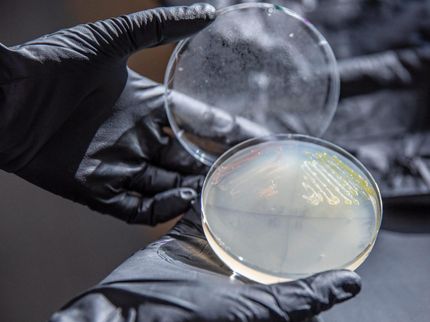Plastic from Wood
X-ray analysis points the way to lignin-based components made to measure
Advertisement
The biopolymer Lignin is a by-product of papermaking and a promising raw material for manufacturing sustainable plastic materials. However, the quality of this naturally occurring product is not as uniform as that of petroleum-based plastics. An X-ray analysis carried out at DESY reveals for the first time how the internal molecular structure of different lignin products is related to the macroscopic properties of the respective materials. The study, which has been published in the journal Applied Polymer Materials, provides an approach for a systematic understanding of lignin as a raw material to allow for production of lignin-based bioplastics with different properties, depending on the specific application.

Lignin is a promising raw material (left) for thermoplast (right) production.
KTH Stockholm, Marcus Jawerth
Lignin is a class of complex organic polymers and responsible for the stability of plants, stiffening them and making them “woody” (i.e. lignification). During paper production, lignin is separated from cellulose. Lignin forms so-called aromatic compounds, which also play a key role in manufacturing synthetic polymers or plastics. “Lignin is the biggest source of naturally occurring aromatic compounds, but until now it has been viewed by the paper industry primarily as a by-product or a fuel,” explains Mats Johansson from the Royal Institute of Technology (KTH) in Stockholm, who led the research team. “Millions of tonnes of it are produced every year, providing a steady stream of raw material for new potential products.”
Some first applications of hard lignin-based plastics (thermosets) already exist. However, their properties often vary and until now it has been difficult to control them specifically. The Swedish team has now shed light on the nanostructure of different fractions of commercially available lignin at DESY’s X-ray source PETRA III. “It turns out that there are lignin fractions with larger and smaller domains,” reports the principle author Marcus Jawerth, of Stockholm’s KTH. “This can offer certain advantages, depending on the particular application: it makes the lignin harder or softer by altering the so-called glass transition temperature at which the biopolymer adopts a viscous state.”
Among other things, the X-ray analysis revealed that those types of lignin whose central benzene rings are arranged in the shape of a T are particularly stable. “The molecular structure affects the macroscopic mechanical properties,” explains DESY’s Stephan Roth, who is in charge of the P03 beamline at which the experiments were conducted and who co-authored the paper. “This is the first time this has been characterised.” As a natural product, lignin comes in numerous different configurations. Further studies are needed to provide a systematic overview of how different parameters affect the properties of the lignin. “This is very important in order to be able to manufacture materials reproducibly, and in particular to predict their properties,” says Roth, who is also a professor at KTH Stockholm. “If you want to use a material industrially, you need to understand its molecular structure and know how this is correlated with the mechanical properties.”
According to Jawerth, up to two thirds of the lignin produced during the paper production process could be turned into polyesters and serve as a starting material for making plastics. “Along with cellulose and chitin, lignin is one of the most ubiquitous organic compounds on Earth and offers enormous potential for replacing petroleum-based plastics,” says the scientist. “It’s far too valuable to simply burn it.”



























































